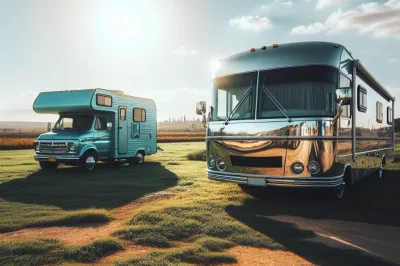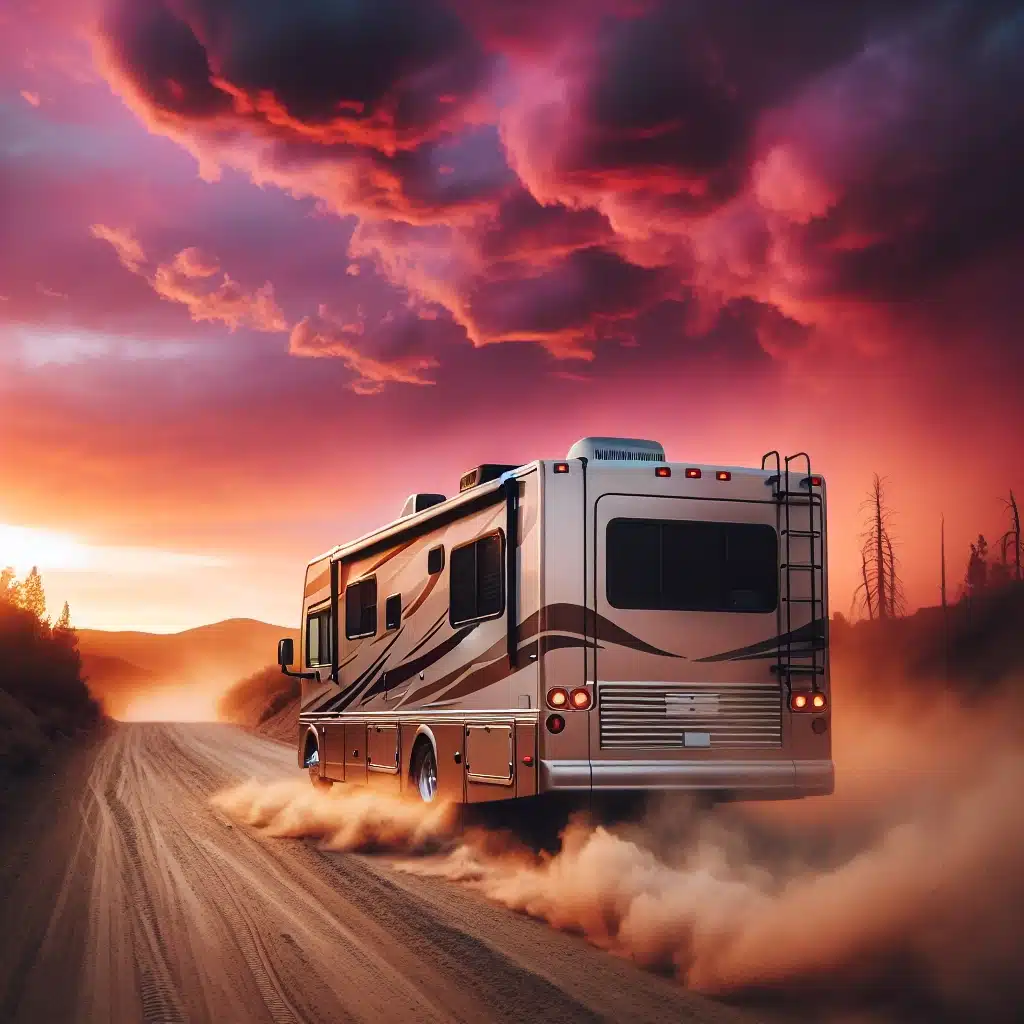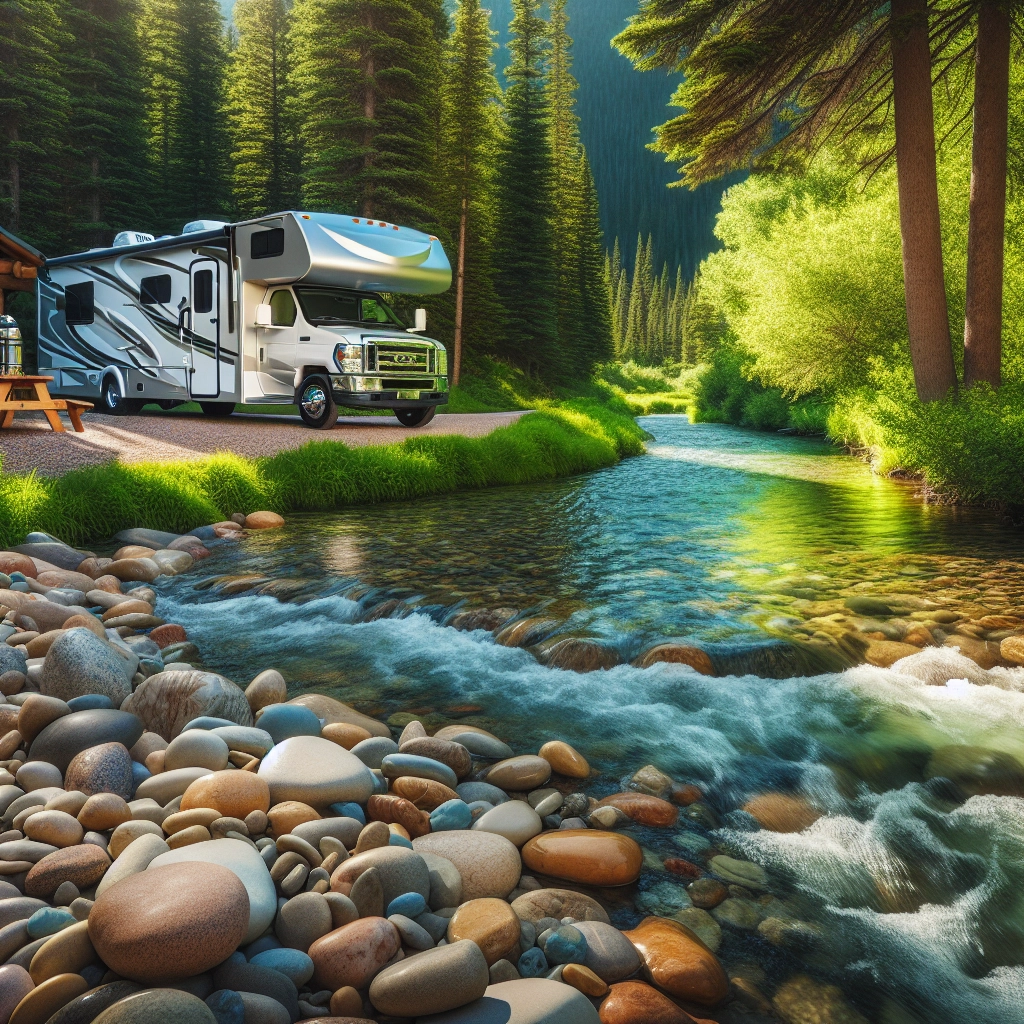Table of Contents

Welcome to the sun-drenched world of off-grid RV living! If you’re looking to break free from the tether of traditional campgrounds and harness the power of the sun for your adventures, you’ve come to the right place. Let’s get your RV powered up and ready to roam wherever the road may lead, with the sun as your generous fuel station.
Soak Up the Sun: Your Ultimate Guide to Off-Grid Solar for RV Life
Imagine never having to search for a hookup again, or being able to camp in pristine, remote locations without sacrificing comfort. That’s the freedom off-grid solar power can offer. I’m here to guide you through the essentials of setting up a solar system that meets your needs, keeps your batteries charged, and ensures you have power when and where you need it.
Key Takeaways: Quick Tips to Harness Solar Energy
- Start with a clear understanding of your power needs to choose the right size solar system.
- Quality solar panels are an investment in long-term energy reliability.
- A charge controller is crucial to protect your batteries from overcharging.
- Deep-cycle batteries are the go-to choice for storing your solar power.
- An inverter will convert stored energy into usable power for your RV’s appliances.
Understanding the Heart of Your Solar Power System
The core of any solar power setup is the solar panel itself. These remarkable devices convert sunlight into electricity, but not all panels are created equal. You’ll want to choose panels that are efficient, durable, and right for the size of your RV’s roof. Remember, more surface area typically means more power, so measure your available space carefully.
Choosing the Right Solar Panels for Your Roaming Home
When selecting solar panels, consider the type – monocrystalline panels are highly efficient and perform well in various lighting conditions, making them a favorite among RVers. Polycrystalline panels can be more cost-effective but may require more space for the same output. Thin-film panels are lightweight and flexible, perfect for RV roofs that can’t bear much weight.
Charge Controllers: The Guardians of Your Solar Battery Bank
A charge controller is like a bouncer for your batteries, ensuring they get the energy they need without overcharging. There are two main types: PWM (Pulse Width Modulation) and MPPT (Maximum Power Point Tracking). MPPT controllers are more efficient and can handle higher power inputs, making them a wise choice for larger systems.
Battery Banks: How to Store that Precious Sun Juice
Your battery bank is where the sun’s energy is stored for later use. Deep-cycle batteries are best for RV solar systems because they’re designed to be discharged and recharged many times. You’ll want to choose a battery capacity that can store enough power to meet your needs, even on days when the sun isn’t shining as brightly.
Power Inverters: Flipping the Current for Everyday Use
Power inverters are the magic boxes that turn the DC power stored in your batteries into AC power that can run your RV’s appliances. The size of the inverter you’ll need depends on the wattage of the appliances you want to run. It’s a good idea to add up the wattage of everything you’ll use simultaneously to determine the right size inverter for your setup.

Calculating Your Solar Needs: The Road to Energy Independence
To truly embrace off-grid living, you need to know how much power you use. Start by listing all your electronic devices and appliances, then tally up their wattage. Once you have your daily power usage, you can start to size your solar system accordingly. It’s always better to overestimate a bit to ensure you have enough power, even on cloudy days.
Watt’s Up? Determining Your Daily Energy Consumption
Knowing your daily energy consumption is like understanding how much water you’ll need on a hike. To figure it out, list all your electronic devices and appliances. Check each item for its wattage, which is often listed on the device or in its manual. Add up the wattage of everything you plan to use in a day, and you’ve got your daily consumption. Don’t forget to account for how many hours you’ll use each item; a TV might use more watts than a light bulb, but if it’s only on for an hour, it uses less energy overall.
Sun Coverage: Matching Panel Capacity with Power Needs
Your solar panels need to meet or exceed your daily energy consumption. If you’ve determined you use 2,000 watt-hours per day, you’ll want enough solar panels to produce that much on an average day. Remember, solar panels don’t produce their maximum output all day long; the sun’s angle and intensity vary. A good rule of thumb is to assume about 5-6 hours of effective sunlight for calculating your panel needs.
- Calculate your average daily watt-hour use.
- Estimate the effective sunlight hours in your area.
- Divide your daily watt-hours by sunlight hours to get the needed wattage.
- Consider adding a buffer to your calculation for less sunny days.
Banking on Batteries: Sizing Up for Energy Assurance
Your battery bank should have enough capacity to store at least a couple of days’ worth of energy. This ensures you have power during periods of bad weather or if you’re using more energy than usual. To determine the size of your battery bank, take your daily energy consumption and multiply it by the number of days you want to cover. Then, consider that batteries shouldn’t be discharged completely for longevity, so add about 20-50% more capacity to your total.
Why the Right Inverter Size Matters
Choosing the right inverter size is about more than just matching wattage. If your inverter is too small, it won’t power your appliances. Too large, and you’ve wasted money and efficiency. Add up the wattage of all the devices you might use at the same time, and pick an inverter that can handle that load. Also, consider surge wattage – the extra power needed when some devices start up. Your inverter should handle the surge wattage without a hitch.
Installation Insights: Setting Up for the Solar Road Ahead
Installing your solar setup is an exciting step towards energy independence. With the right tools and a bit of know-how, you can secure your panels, wire your system, and start soaking up the sun’s free energy. Let’s walk through the basics to ensure a smooth installation.
Securing Solar Panels: A Step-by-Step Guide for RV Roofs
Mounting solar panels starts with a clean, dry roof. Use mounting brackets specifically designed for RVs to avoid damaging your roof. Space the panels out evenly and bolt them down securely, ensuring there’s enough room to tilt them towards the sun if necessary. Seal any holes with a high-quality sealant to prevent leaks.
Connecting the Dots: Safely Wiring Your Solar Components
Wiring your solar system is all about creating a secure and efficient flow of electricity. Use the right gauge of wire to handle the current, and make sure all connections are tight and waterproof. Run wires through a conduit for protection and organize them with zip ties to prevent damage from vibrations while you’re on the move.
Troubleshoot Like a Pro: Common Solar Set-Up Mistakes
Even the best of us can run into issues when setting up a solar system. Common mistakes include underestimating energy needs, choosing the wrong type of battery, or installing panels in a shaded area. Always double-check your calculations, ensure your batteries are compatible with your system, and place panels where they’ll get maximum sun exposure.
- Incorrectly calculating energy needs can lead to an underpowered system.
- Using the wrong battery type can reduce efficiency and lifespan.
- Improperly sealed roofs can lead to water damage.
- Shaded panels won’t produce their full potential, reducing overall power.

The Care and Feeding of Your Solar System
Just like any home, your RV and its solar system need regular maintenance to stay in tip-top shape. Think of it as taking care of a pet – it doesn’t take much, but a little love goes a long way. Here’s how to keep your solar setup happy and healthy, so it keeps powering your adventures without a hitch.
Keep It Clean: Solar Panel Maintenance Must-Dos
Keeping your solar panels clean is crucial. Dust, dirt, and bird droppings can block sunlight and reduce your panels’ efficiency. A simple wash with water and a soft brush can do wonders. Try to clean your panels every few months or more often if you’re traveling through particularly dusty areas. And always be gentle to avoid scratching the surface.
Monitoring and Optimizing: Smart Energy Management
Energy management is all about knowing how much power you’re making and using. Modern solar systems often come with monitoring systems that let you track this on your phone or a dedicated display. Use this data to find patterns in your energy usage and make adjustments. Maybe you’ll find that charging your gadgets during peak sun hours saves a lot of battery life for the evening.
Battery Life: Tips to Extend Your Energy Reservoirs
Batteries are the backbone of your solar system. To keep them going strong, avoid discharging them completely. Most have a sweet spot – typically around 50% discharge – where they’ll have a longer life. Also, keep them at a stable temperature as much as possible, as extreme cold or heat can shorten their lifespan.
When Things Don’t Go as Planned: Solar System Troubleshooting
Even with the best setup, things can go awry. But don’t worry, most solar system issues are fixable with a little know-how. Let’s look at some common problems and how to get your system back on track.
Identifying and Fixing Common Solar Hiccups
If your system isn’t performing as expected, first check the basics. Are the panels clean? Are all connections secure? Is the charge controller showing any error messages? Often, the fix is as simple as tightening a loose wire or clearing off some debris from a panel.
Low Power Output: Diagnosis and Remedies
When your solar system’s power output dips, it’s time to play detective. Check for shading from new obstacles, inspect for damaged panels, and ensure your charge controller settings are correct. Sometimes, repositioning your panels to catch more sun or replacing a worn-out cable is all it takes to boost those energy levels.
Battery Bank Issues: What to Do When Your Storage Solution Stumbles
Battery problems can be tricky, but they’re often due to age or improper charging. If your batteries aren’t holding a charge like they used to, test each one individually to find the culprit. Proper maintenance, like keeping terminals clean and ensuring they’re charged correctly, can prevent many issues. And remember, when it’s time to replace, recycle the old ones responsibly.
Solar Living Made Easier: Handy Gadgets and Upgrades
As you settle into the solar-powered RV lifestyle, you’ll discover a whole world of gadgets and upgrades that can make your experience smoother and more efficient. From high-tech monitoring systems to smart appliances, these tools are designed to work hand-in-hand with your solar setup, ensuring you get the most out of every ray of sunshine.
Boosting Efficiency with Solar Gadgets
Efficiency is key when living off-grid, and there are plenty of gadgets to help you maximize your solar system’s performance. For instance, solar charge controller monitors can provide real-time data on power input and battery health, helping you make informed decisions. LED lighting swaps out power-hungry bulbs for energy-sipping alternatives, and solar-powered fans keep air circulating without draining your batteries.
- Solar charge controller monitors for real-time system data
- LED lighting to reduce energy consumption
- Energy-efficient appliances designed for solar systems
- Solar water heaters for hot showers without the power draw
- Smart thermostats that adjust to save energy
Portable Power: Solar Generators for Extra Backup
Even the best-laid solar systems can benefit from a backup. Portable solar generators are a great solution for those times when you need a little extra power. They’re compact, easy to use, and can be a lifesaver during extended cloudy periods or unexpected high-energy demands. Plus, they’re perfect for powering gadgets when you’re away from your RV, like at the beach or on a hike.
- Portable solar generators for backup power
- Compact and easy to carry for outdoor activities
- Quick to set up for an instant power boost
- Can be charged from your main solar panels or separately
Upgrade Paths: Expanding Your Solar System as Needs Grow
Your solar needs might change as you spend more time on the road. Maybe you’ve picked up a new hobby that requires power, or you’re traveling to places with less sunlight. Upgrading your system can be as simple as adding more panels or batteries. You could also consider stepping up to a more powerful inverter to handle additional appliances. The beauty of solar is its scalability – you can grow your system as your needs evolve.
- Add more panels for increased power generation
- Expand your battery bank for greater storage capacity
- Upgrade to a more powerful inverter for additional appliances
- Consider higher efficiency panels for a more compact setup
Maximizing the Off-Grid Experience
Living off-grid with solar power is about more than just the technical setup; it’s a lifestyle. By embracing energy-conscious habits and making a few adjustments, you can extend your off-grid time, reduce your environmental footprint, and enjoy the freedom of the open road with fewer limitations.
Beyond the Batteries: Embracing Energy-Conscious RV Living
Energy-conscious living starts with mindfulness about how and when you use power. It’s about turning off lights when you leave a room, unplugging chargers when not in use, and choosing energy-efficient appliances. It’s also about embracing the natural rhythms of the day – waking with the sun and winding down as it sets, tapping into the natural energy cycle.
- Turn off appliances and lights when not in use
- Unplug chargers to prevent phantom power draw
- Use natural light during the day to save energy
- Invest in energy-efficient appliances and gadgets
Enhancing Power Autonomy with Lifestyle Adjustments
Small lifestyle adjustments can significantly enhance your power autonomy. For example, cooking with a solar oven during the day eliminates the need for power-hungry stoves. Scheduling energy-intensive tasks like laundry or vacuuming for sunny days when your panels are at peak production can also help you stay off-grid longer.
- Cook with a solar oven or grill to save energy
- Plan energy-intensive tasks for peak solar production times
- Use a clothesline instead of an electric dryer
- Opt for manual tools over electric ones when possible
Finding Your Solar Sweet Spot: Balancing Comfort and Sustainability
Finding the perfect balance between comfort and sustainability is the key to a happy off-grid life. It’s about understanding your energy needs and meeting them in the most efficient way possible. This might mean investing in a high-quality solar setup or simply learning to enjoy the simple pleasures of life on the road. When you find that sweet spot, you’ll know – because living off-grid will feel as natural as the sunrise.
- Invest in quality solar equipment for long-term sustainability
- Embrace simple pleasures and natural living
- Balance your energy use with your comfort needs
- Adapt to the environment and seasonal changes
FAQ: Shining a Light on Your Solar Queries
How Much Solar Power Do I Really Need for Full-Time RV Living?
The amount of solar power you need hinges on your lifestyle and energy habits. Start by calculating the wattage used by all your devices and appliances in a day. Then, factor in a little extra for those just-in-case scenarios. A good rule of thumb is to aim for a system that provides 20-30% more power than your daily usage. This helps ensure you have enough energy during less sunny periods or if your power consumption increases unexpectedly.
Can I Install a Solar Power System on My RV Myself?
Yes, you can install a solar power system on your RV by yourself, especially if you’re handy and comfortable with basic electrical concepts. Many solar kits come with instructions tailored for DIY enthusiasts. However, if you’re not confident in your abilities or your system is particularly complex, it’s wise to seek professional help. Safety first—working with electricity can be dangerous if you’re not sure what you’re doing.
What Are the Best Types of Batteries for Solar RV Systems?
Deep-cycle batteries are your best bet for solar RV systems. They’re designed to be regularly discharged and recharged without damage. There are several types, including lead-acid, AGM (Absorbent Glass Mat), and lithium batteries. Lithium batteries are pricier but offer longer lifespans, higher efficiency, and lighter weight, making them a popular choice for those who can afford the initial investment.
How Do I Maintain My Solar Panels While I’m On the Move?
Maintaining your solar panels is all about keeping them clean and free from obstructions. Regularly check for and remove debris, bird droppings, or dust that could block sunlight. Use a soft cloth or brush and soapy water to gently clean the panels. It’s also wise to inspect the mounting brackets and tighten any loose bolts to ensure your panels stay secure while you’re cruising down the highway.
As you venture into the world of off-grid RV living, remember that solar power is more than just a way to keep your lights on. It’s a lifestyle that embraces freedom, sustainability, and the thrill of the open road. With the sun as your companion, every day is an opportunity to explore new horizons. So go ahead, chase that sunset, and let solar power illuminate your journey. Safe travels and sunny days to you, fellow solar-powered road warrior!
- Boondocking RVs: Flexible Solar Solutions – 3 March 2024
- Renewable Energy Tips for Full-Time Boondocking RVers – 2 March 2024
- Boondocking Solar Power Systems: Sizing Options & Solutions for Motorhomes – 1 March 2024
